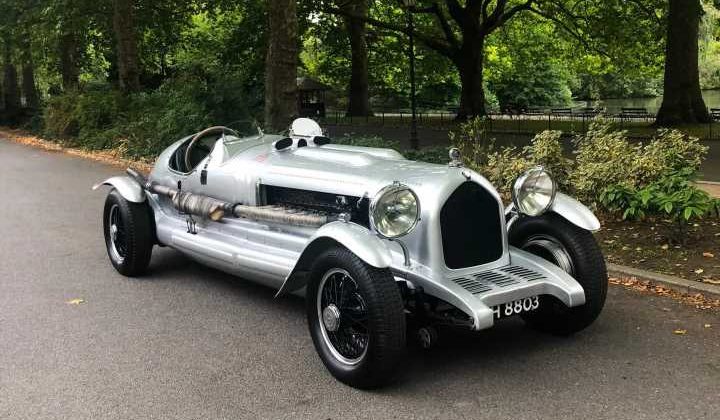Madcap and magical in equal measure…
By John Howell / Saturday, 24 December 2022 / Loading comments
Here’s something a wee bit different. It’s a Rolls-Royce, but not your regular Shadow or Spirit. And if you’re one of those people who says ‘Bet that drinks petrol; what MPG do ya get?’ whenever you come across a car with a big engine, then this will blow your mind. There’s no wheezy 6.75-litre eco engine tucked away in there. This is the Rolls-Royce of Rolls-Royce engines: the 27-litre PV-12 Merlin.
Now, I say Merlin, but the advert says that this engine was from a Hurricane and then it was converted to a Meteor Mk1 engine. Technically, is it a Merlin, then? I am not 100 per cent sure what the purists would say about that, because Meteor engines were detuned and not rated for aero use. They originally came about because Rolls-Royce was recovering parts from crashed Merlin engines and refurbishing them. They had all these parts, which couldn’t be used in the aero engines because they weren’t grade-one quality, so needed to find another use for them.
The problem was that the aero engines were running at consistently high revs to produce maximum power, and you don’t want something going bang at 30,000 feet because of an iffy bit. Tanks don’t tend to drop like a stone when the engine dies, so William Robotham – who was an executive in the Rolls-Royce car division and found himself with nothing to do at the time – spearheaded the conversation of reconstituted Merlin aircraft engines for use in tanks. The tanks engines didn’t need to rev as high, so the reliability wasn’t as critical, and that’s how the Meteor engine came about. The Merlin was in service up in the skies, in everything from the Spitfire, Hurricane and Lancaster to the USAF Mustang; meanwhile, the Meteor was on ground duties in the likes of the Cromwell, Challenger and Comet tanks.
Anyway, Merlin or Meteor, that’s the history lesson done with. What’s important here is this is one of the greatest-sounding engines ever built. Many of you will have been to air shows and heard the distinctive thunder of a Merlin overhead, and it really is an iconic noise. That, and the intimate association that these engines have with the Allied victory in World War II, makes them more than the sum of their many complex parts. Hence, more than a few have been plonked in a metal frame and people make YouTube videos of them starting up. Guy Martin has one. He started it up in his workshop and attempted to run it to its 2,800rpm peak revs. At which point it took off, destroying a wall, a staircase and lots of other stuff in between.
Those with even deeper pockets stick them in cars, though. And why not? Jay Leno has two Merlin-powered motors. One is the custom Bentley built by Bob Petersen that was featured on Top Gear, and the other is a rather elegant sports-tourer bodied car built by a man called Paul Jamerson. Jamerson’s become something of an expert on aero-engined cars, and he’s the engineering brain behind this creation.
It’s built on a 1930 Phantom II chassis, with the aluminium bodywork crafted by Alan Jenner of Hastings. The numbers it makes are, as with all these cars, quite astounding. 800hp and 1,500lb ft of torque, and that’s delivered at just 1,500rpm. As the advert says, the car is ‘completely traction limited’. You don’t say. It also says that it is theoretically geared to 190mph, but no one has been brave enough to test that out. The owner sounds like he has the fighter-pilot spirit, though, having taken it to a plucky 160mph in third, when it was ticking along gently at 3,000rpm. It’s also clocked 111mph over a standing-quarter.
It has plenty of other nice touches to do justice to that Merlin/Meteor motor. The 150-litre fuel tank is from a D.H. Rapide Biplane, and the 14-gallon oil tank is from a Fairey Firefly – a strike fighter plane that used the even larger 37-litre Rolls-Royce Griffon V12. It’s even got seat belts and air ducts for the front brakes from a Lightning jet. So there you have it: madcap and magical in equal measure. And if anyone writes a comment along the lines of ‘How much?’ or ‘Nearly bought one of those for £5,000 in 1992,’ you’re heading straight to the naughty step. And I’ve primed it with glue.
Source: Read Full Article
